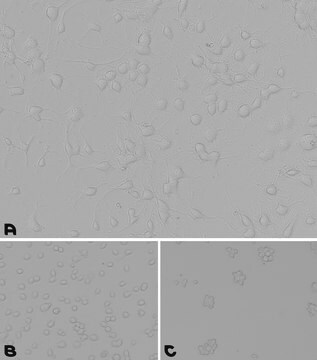LPDL001
Laminin/Poly-D-lysine Coating Solution
0.2 μm filtered, BioReagent, suitable for cell culture, Ready-to-use mixture
Synonyme(s) :
Attachment Factors, Coating mix, Laminin, PDL, Poly-D-lysine
Se connecterpour consulter vos tarifs contractuels et ceux de votre entreprise/organisme
About This Item
Code UNSPSC :
12352202
Nomenclature NACRES :
NA.25
Produits recommandés
Niveau de qualité
Stérilité
0.2 μm filtered
Gamme de produits
BioReagent
Forme
liquid
Technique(s)
cell culture | mammalian: suitable
Conditions d'expédition
wet ice
Température de stockage
2-8°C
Description générale
Laminin/Poly-D-Lysine Coating Solution is a ready-to-use attachment factors mix solution, prepared in phosphate-buffered saline and is 0.2µm filtered. It is used to coat cell culture flasks, dishes, and multi-well plates and used to promote the attachment, spreading, and proliferation of a variety of cell types that require ECM-coated surfaces for adhesion and 2D cell-culture growth. The combination of Poly-D-Lysine and Laminin has been used for optimal attachment and promotion of neurite outgrowth in culture. It is suitable for culturing many different types of Peripheral Nervous System (PNS) and Central Nervous System (CNS) networks and is useful for promoting neural cell attachment and differentiation. The Laminin/Poly-D-lysine solution can also be used with cells that digest poly-L-lysine polymers and cause an excessive uptake of L-lysine.
Application
Laminin/Poly-D-Lysine Coating Solution can be used in:
- Attachment and spreading of a variety of cell types
- Enhancement of neuronal cell attachment to plastic and glass
- Support of neurite outgrowth
- Suitable for use with serum-free or reduced -serum cultures
Actions biochimiques/physiologiques
Laminin proteins are integral components of structural scaffolding in animal tissues. Laminin has active domains for collagen binding, cell adhesion, heparin binding, and neurite outgrowth fragment. Laminin supports growth and differentiation of many cell types including epithelial, endothelial, neural, muscle and liver cells. Poly-D-lysine hydrobromide is a nonspecific attachment factor for cells, useful in promoting cell adhesion to solid substrates by enhancing electrostatic interaction between negatively charged ions of the cell membrane and the culture surface. After absorption to the culture surface, Poly-D-lysine increases the number of positively charged cell binding sites.
Composants
Laminin is a large basement membrane glycoprotein and composed of three different polypeptide chains, termed α, β and γ. The cohesion between these chains is the result of many inter and intrachain disulfide bonds. Together, they cause the molecule to look like a crucifix.
Poly-D-lysine hydrobromide molecular weight is 70,000-150,000 Da, a positively charged amino acid polymer.
Poly-D-lysine hydrobromide molecular weight is 70,000-150,000 Da, a positively charged amino acid polymer.
Notes préparatoires
LPDL001 is a ready to use mixture composed of Laminin and Poly-D-Lysine. It is filtered using 0.2µm filter. Gently mix the Laminin/Poly-D-Lysine Coating Solution a few times to form a homogenous solution before use. For use as a coating solution, cover the entire culture surface area, approximately 0.2-0.25 mL/cm2. Incubate at room temperature for 2-3 hours and carefully aspirate the solution and wash 3 times with sterile PBS before plating cells. The coated tissue culture vessels can be used immediately or stored at 4 °C for up to one week filled with PBS and wrapped in parafilm. Remove PBS only when ready to plate the cells. Do not let the coated plates dry completely.
Code de la classe de stockage
12 - Non Combustible Liquids
Classe de danger pour l'eau (WGK)
WGK 1
Certificats d'analyse (COA)
Recherchez un Certificats d'analyse (COA) en saisissant le numéro de lot du produit. Les numéros de lot figurent sur l'étiquette du produit après les mots "Lot" ou "Batch".
Déjà en possession de ce produit ?
Retrouvez la documentation relative aux produits que vous avez récemment achetés dans la Bibliothèque de documents.
Notre équipe de scientifiques dispose d'une expérience dans tous les secteurs de la recherche, notamment en sciences de la vie, science des matériaux, synthèse chimique, chromatographie, analyse et dans de nombreux autres domaines..
Contacter notre Service technique






